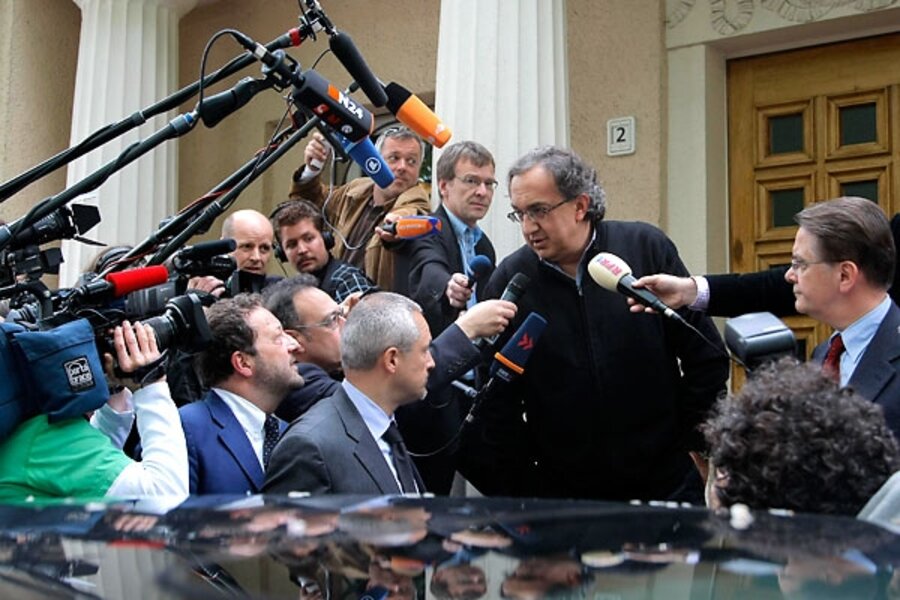Fiat's race from punchline to potential white knight for Detroit
Loading...
Berlin – "What do you call a Fiat driver nervous about speeding? A wishful thinker."
Such jokes have long plagued Italy’s venerable national carmaker Fiat – a name that some have claimed stands for "Fix It Again Tomorrow" – after years spent turning out low-quality cars and posting annual losses.
That was before jet-setting, jazz-loving Sergio Marchionne, an Italian businessman, took over Fiat five years ago, promptly cleaned house, and set about rebuilding the brand.
No longer a punchline, the company now finds itself the most talked-about carmaker in the industry. It’s attempting to position itself as a major player among global manufacturers and a white knight with the potential to save two of Detroit’s three struggling auto giants, Chrysler and General Motors.
At a time when car companies worldwide are retreating from the bear economy, Fiat is going the other direction: It recently secured a majority stake in Chrysler and is vying to purchase GM’s European operations, which includes Germany’s Opel, Britain’s Vauxhall, and Sweden’s Saab – it's a move that could keep Detroit's top carmaker out of bankruptcy.
Mr. Marchionne was in Berlin this week to continue pressing the German government to support his bid for Opel. Acquiring GM’s Europe arm, along with Chrysler, would make Fiat the world’s second-largest car manufacturer behind Japan’s Toyota.
“It looks like everything Fiat wants, Fiat is getting,” Erich Merkle, an auto industry analyst, told Bloomberg recently.
Fiat’s recent rise belies its current position among Europe’s carmakers. It is the sixth-largest producer of cars by volume on the Continent, well behind the likes of Germany’s Volkswagen, which produced more than 6 million cars last year (Fiat produced 2.5 million).
But large players like VW have, so far, been unwilling to come to the aid of ailing brands – to say nothing of their own struggles: VW and German luxury brand Porsche are considering a merger.
That, in turn, has created a window of opportunity for Marchionne, who has shown himself to be a risk-taker, according to auto industry analysts, including Stephen Pope, of Cantor Fitzgerald in London. Fiat is “in a position that they can afford to cherry pick,” Mr. Pope says. “There is nobody else right now riding the white horse up the motorway to help these companies.”
The turnaround man
When Marchionne took over as Fiat CEO in 2004, the company hadn’t posted a profit in four years. A well-traveled, lifelong expatriate – as an adult, he lived mostly outside Italy – Marchionne arrived in Turin, Fiat’s home, having already transformed another company owned by Italy’s Agnelli family, Swiss goods inspection firm SGS SA.
He was determined to shake things up. He fired older managers and replaced them with fewer, younger leaders. He tightened up the company’s finances and was instrumental in key redesigns of the 500 and Bravo, Fiat’s two legacy models, which brought the company a hipper look that contrasted with its century-old heritage.
All the while, Marchionne was thinking about economies of scale and what it takes for a carmaker to survive in today’s economy. Marchionne says a carmaker cannot make it unless it can produce about 6 million models every year. That's the main conceit behind Fiat’s push to acquire both Chrysler and GM Europe, which would push its manufacturing close to that level.
Relying on government money
Fiat’s bid for both companies is noteworthy in that it involves no cash from its own pocket. Fiat is still paying down a significant amount of its own debt, and doesn’t have the cash to buy either Chrysler or GM.
It’s looking for governments to pony up – one reason some industry analysts seem cool toward Fiat’s plans.
“I wouldn’t say that Fiat is in a strong position. They are benefiting from a lot of governments willing to hand out money to the car industry,” says Jan Hagen, an economist at the European School for Management and Technology in Berlin. “This is a huge gamble, and the only way that it’s going to work is that governments are willing to hand out money.”
Fiat’s bid for Chrysler was recently approved by a US Treasury Department task force. The deal would net Fiat a 20 percent stake in Chrysler from the outset, which would rise eventually to 35 percent. Marchionne is expected to take over as Chrysler CEO when the company emerges from bankruptcy court later this month.
Most significantly, the Chrysler deal keeps alive the hope of more than $6 billion in loans from the US government.
Analysts say a Fiat-Chrysler merger makes sense, given the types of cars both produce: Fiat is known for its fuel-efficient, compact models; Chrysler is known for its trucks and SUVs, including the Jeep brand.
Fiat acquiring the likes of Opel could keep GM out of bankruptcy. But this deal faces more skepticism in Germany. “The logic of Opel and Fiat is more difficult to understand,” says Ferdinand Dudenhöffer, director of the Center for Automotive Research in Leverkusen, Germany. “They are in the same market, they have the same car, and the same over capacity.
“I don’t believe that it will be successful.”
This being an election year in Germany, talks between Fiat and Opel have turned into a political football, with the country’s two major parties divided on how to proceed.
The Social Democrats back the concerns of unions that represent about 25,000 Opel employees, who fear a sale to Fiat will mean job losses. Chancellor Angela Merkel’s Christian Democratic Party is said to be more keen on a deal.
Fiat says it will keep all three of Opel’s major German manufacturing centers open and focus on layoffs elsewhere – a statement that has workers in Britain worried. The company is asking the German government for bridge loans totaling between $6.6 billion to $9.3 billion to make the deal happen.
“The jury is very much still out on this,” says Cantor Fitzergerald’s Pope.





